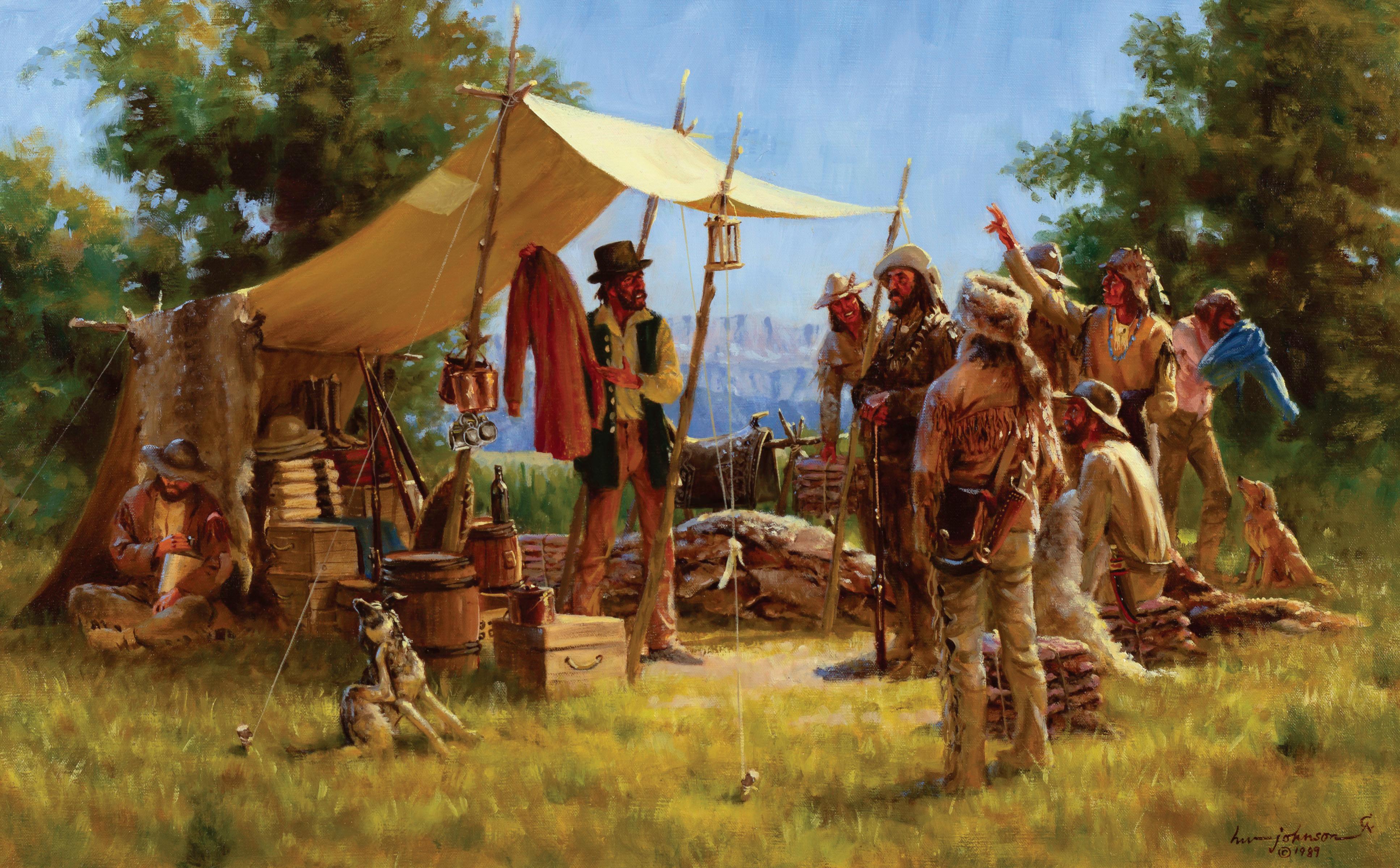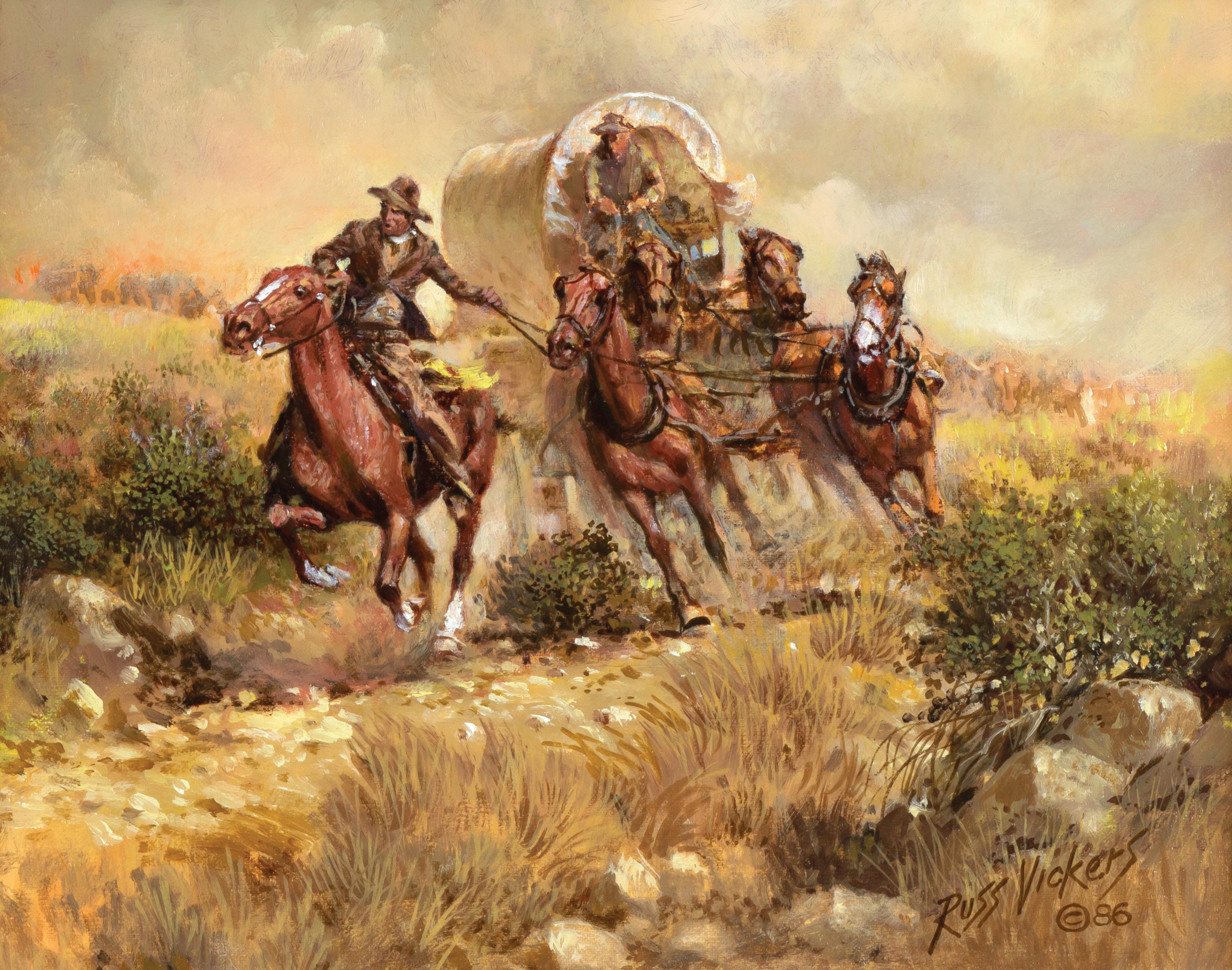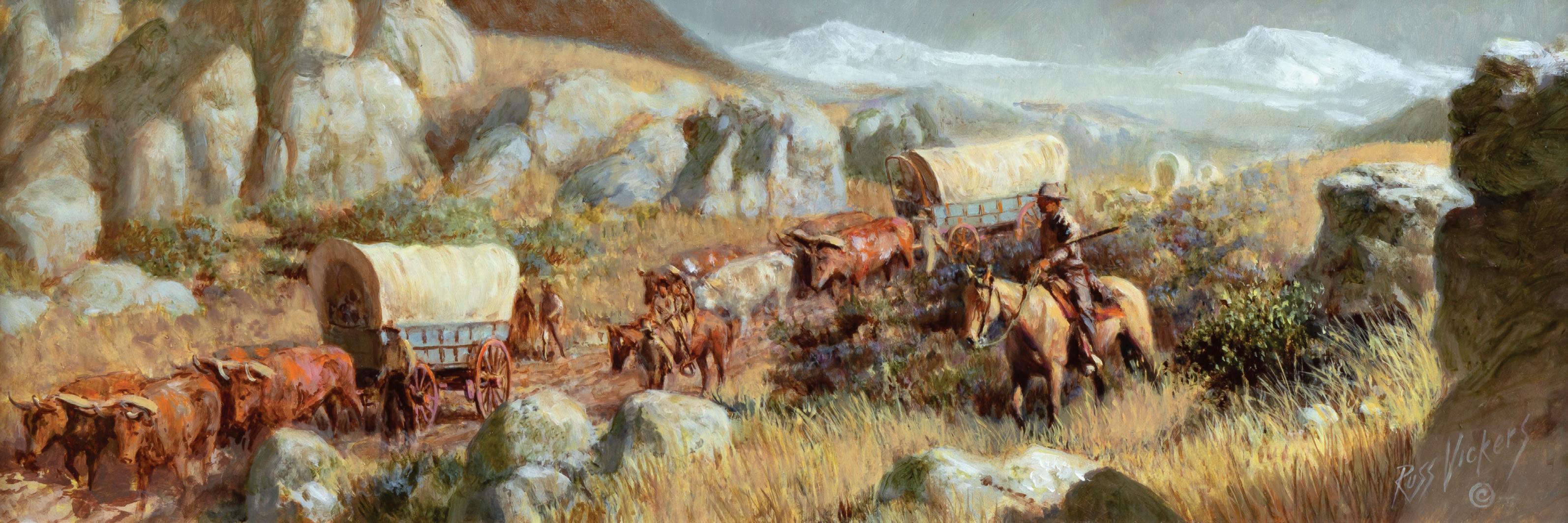AN OFFERING OF IMPORTANT WESTERN ART FROM A PRIVATE COLLECTION

Trailside Galleries is pleased offer a selection of works from a noted private collection. Over almost six decades, this California based couple built an exemplary collection of both historical and contemporary western art.
In particular, the gentleman of the family was always somewhat of a walking dictionary of American history. Early in their marriage, this husband and wife would spend their weekends looking at western art throughout California.
At the time, they didn’t have a dime between them to spend on fine art so it was all wishful dreaming. Some years later, while visiting family in the Phoenix area, they were given tickets to the annual Cowboy Artists of America Exhibition and Sale at the Phoenix Art Museum. Meeting many of the artists they had admired for years and seeing the artwork up close and personal was the beginning of what would be a lifetime passion for collecting American western art. Not surprising, the husband went on to become President of the Board of the Cowboy Artists of America Museum in Kerrville, Texas, now known as the Museum of Western Art. From there, the family collection continued to grow in both depth and value.
Reminiscing, the wife recalls that the best part of being avid western art buyers was the longterm friendships made along the way with collectors and artists alike. Their home in California was specifically designed and built in order to house their growing and much prized art collection. Over many years, several of the artists whose works graced the walls of the home were frequent guests.
MELVIN WARREN (1920-1995)
The son of a ranch hand and cowboy, Melvin Warren was born in 1920, moving with his family from ranch to ranch throughout California, Arizona and New Mexico before settling in Texas at the age of fourteen. No stranger to ranch work, Warren would later use his firsthand experiences to fuel his artistic endeavors.
After serving in the Air Force during World War II, Warren attended Texas Christian University in Fort Worth, Texas and earned a degree in fine art. After graduation, he worked as a commercial painter by day and cowboy artist by night, eventually studying art under Samuel Ziegler.
He became a keen observer of ranch life and Native American culture. By the 1960s, Warren would finally gain enough success with galleries to allow him to quit his day job and focus on his art full-time. In 1968, Warren joined the Cowboy Artists of America, winning the group’s Memorial Award in his very first exhibition. Both a skilled painter and sculptor, Warren focused his subject matter on the heroic west. Today, collectors instantly recognize his naturalistic depictions of the West, infused with light and warm earth tones with influences of Impressionism.
 Charles Melvin Warren (1920-1995)
Old Man of the Desert, pastel on paper, 29 x 21 in., $7,500
Charles Melvin Warren (1920-1995)
Old Man of the Desert, pastel on paper, 29 x 21 in., $7,500
CHARLES WINFIELD MILLER (1922-1995)
Charles Winfield Miller’s early association with two of the greats of American Illustration, Haddon Sundblom and Harry Anderson, instilled in him a profound respect for excellence and integrity in the painting process. In the commercial and editorial field, his oeuvre ranged from magazines to Playboy cartoons and large outdoor advertisements.
After a long and successful career as a freelance illustrator, portrait painter and teacher, Miller eventually moved to Jackson Hole, Wyoming to follow his passion for painting Western and Native American scenes and portraits.
 Charles Winfield Miller (1922-1995)
Pony Raid, oil on canvas, 40 x 24 in., $5,000
Charles Winfield Miller (1922-1995)
Pony Raid, oil on canvas, 40 x 24 in., $5,000
 Charles Winfield Miller (1922-1995)
The Talking Sun, oil on canvas, 40 x 24 in., $5,000
Charles Winfield Miller (1922-1995)
The Talking Sun, oil on canvas, 40 x 24 in., $5,000
 Charles Winfield Miller (1922-1995)
Listening, oil on canvas, 20 x 14 in., $2,500
Charles Winfield Miller (1922-1995)
Listening, oil on canvas, 20 x 14 in., $2,500
DON TROIANI (B. 1949)
Don Troiani is a traditional academic realist painter well known for his highly accurate historical and military paintings mostly of the Civil War and American Revolution. Born in New York City in 1949, he studied at the Pennsylvania Academy Of Fine Arts and New York City’s Art Students League between 1967 and 1971. With a lifelong focus on America’s military, he has one of the great private artifact collections from the Civil War, the War of 1812, the Revolutionary War and World War II. His vast collection of uniforms, equipage, insignia and weapons all add to the unique dimension of realism he is well known for. He is also an expert researcher with a huge personal military library of over 3,000 volumes. Appropriate backgrounds are found and studied, sometimes sending the artist hundreds of miles from home to examine battlefields and structures firsthand. Due to the amount of research and time that goes into one of his works, it is often years between a painting’s conception and the actual moment the brush is put to canvas.
 Don Troiani (b. 1949)
The Colonel of the Confederacy, oil on board, 27 x 16 in., $6,000
Don Troiani (b. 1949)
The Colonel of the Confederacy, oil on board, 27 x 16 in., $6,000
 Don Troiani (b. 1949) Eagle of the 8th, oil on canvas, 42 x 42 in., $50,000
Don Troiani (b. 1949) Eagle of the 8th, oil on canvas, 42 x 42 in., $50,000
HARVEY JOHNSON (1921-2005)
Harvey William Johnson came by his artistic talent naturally. His father was a noted sculptor and his mother was an accomplished painter. Following in their footsteps, after World War II, Johnson studied at the Art Students League in New York City. He worked for several advertising studios and as an illustrator (often of frontier life) for many pulp magazines. For nineteen years, he was an instructor at the Famous Artists School in Connecticut where he became friends with one of his artistic idols, Harold Von Schmidt.
Eventually, he devoted his artistic talents to interpreting the historic west, particularly the era of the mountain men and the fur trade. In 1966, while reading a copy of Western Horseman magazine, Johnson saw an article about a new organization that was forming, dedicated to the continuation of the western art traditions of Remington and Russell. His query about joining the group was quickly answered making him one of the first artists to apply for membership in the then fledgling Cowboy Artists of America organization.
A stickler for detail, Johnson did extensive research for his illustrations and paintings. Throughout his lifetime, he collected artifacts and books about western history. Johnson and his wife lived in Santa Fe, New Mexico – in an adobe house overlooking the Santa Fe Trail, one of the first trade routes between Mexico and the United States.
 Harvey Johnson (1921-2005)
Furs for Fofarraws, oil on board, 20 x 32 in., $7,000
Harvey Johnson (1921-2005)
Furs for Fofarraws, oil on board, 20 x 32 in., $7,000
 Harvey Johnson (1921-2005)
Robe of Her Son, oil on board, 12 x 9 in., $1,200
Harvey Johnson (1921-2005)
Robe of Her Son, oil on board, 12 x 9 in., $1,200
 Harvey Johnson (1921-2005)
The Medicine of Her Brave, oil on board, 20 x 24 in, $3,000
Harvey Johnson (1921-2005)
The Medicine of Her Brave, oil on board, 20 x 24 in, $3,000

 Harvey Johnson (1921-2005)
The Red Capote, oil on board, 12 x 9 in., $1,000
Harvey Johnson (1921-2005)
Ah - The Stories I could Tell, oil on board, 7 x 5 in., $500
Harvey Johnson (1921-2005)
The Red Capote, oil on board, 12 x 9 in., $1,000
Harvey Johnson (1921-2005)
Ah - The Stories I could Tell, oil on board, 7 x 5 in., $500
 Harvey Johnson, (1921-2005)
Camp of the Running Iron Men, oil on board, 24 x 42 in., $12,000
Harvey Johnson, (1921-2005)
Camp of the Running Iron Men, oil on board, 24 x 42 in., $12,000
 Harvey Johnson, (1921-2005)
A Bent’s Fort Welcome, oil on board, 24 x 36 in., $8,500
Harvey Johnson, (1921-2005)
A Bent’s Fort Welcome, oil on board, 24 x 36 in., $8,500
 Harvey Johnson (1921-2005)
White Man Who Scalps Himself, oil on board, 24 x 44 in., $9,500
Harvey Johnson (1921-2005)
White Man Who Scalps Himself, oil on board, 24 x 44 in., $9,500
FRITZ WHITE, CA (1930-2010)
Fritz White was renown throughout the world for his distinctive style of bronze sculpture and for being a key player in turning Loveland, Colorado into the well-known sculpture community it is today.
Born January 14, 1930 in Milford, Ohio, by the time he was 12, his father had enrolled him in an adult art class in a Cincinnati college. After high school and proudly serving in the US Marine Corp. from 1948 to 1953, Fritz White launched Fancy Lettering, a design studio for sales publications. He later took a position with National Underwriter Company. On a whim in 1961, he loaded up his car with large chunks of marble from Marble, Colorado and thus began his long career in sculpture. At first he worked as a marble sculptor but he soon took up bronze casting.
Fritz White was elected a member of the Cowboy Artists of America organization in 1973 and subsequently became a defining member of the movement toward the artistic recreation of the American West. He received numerous gold and silver medals as well as best-of-show awards. A Fellow of the National Sculpture Society, White also exhibited in some of the nation’s major museums venues including the Gilcrease Museum, the Phoenix Art Museum and the National Cowboy and Western Heritage Museum.
 Fritz White (1930-2010)
Alone With The Nighthawk, bronze ed. of 30, 36 x 6 x 8 in., $4,800
Fritz White (1930-2010)
Alone With The Nighthawk, bronze ed. of 30, 36 x 6 x 8 in., $4,800
 Fritz White (1930-2010)
Out of the Mystic Past, bronze ed. of 15, 21 x 47 x 24 in., $14,000
Fritz White (1930-2010)
Out of the Mystic Past, bronze ed. of 15, 21 x 47 x 24 in., $14,000
Navajo Magic, bronze ed. of 25, 38 x 22 x 15 in., $7,500
 Fritz White (1930-2010)
Fritz White (1930-2010)
ROBERT PUMMILL (B. 1936)
Raised in Southern Ohio, Robert Pummill took his first art course at eleven years of age, his art education furthered by correspondence courses with the Famous Artists School. He later went to night school at the Art Center School of Design in Los Angeles, California while working as an industrial artist. In 1968 he moved to Texas as an illustrator for Vaught Aeronautics and by 1977 was a full time artist.
Today, Pummill hails from the Texas hill country, his hometown of Kerrville once a jumping-off point for trail herds bound north for Dodge City, Kansas. Whether it is the aesthetic beauty of the Texas hill country or the sublime drama of the trail driving era, the colorful cavalcade of longhorns, horses and heroes that once proudly passed by has become a recurrent theme in Pummill’s art. He also paints the wanderers who came west in wagons, Conestogas and Concord coaches, rolling upon an endless expanse of prairie grass.
A former member of the Cowboy Artists of America, Robert Pummill’s study and depiction of the old west and art history have always been an integral part of his life-long desire to learn more about his predecessors and the west.
 Robert Pummill (b. 1936)
Early Morning Mist, oil on canvas, 30 x 40 in., $25,000
Robert Pummill (b. 1936)
Early Morning Mist, oil on canvas, 30 x 40 in., $25,000
 Robert Pummill (b. 1936)
Robert Pummill (b. 1936)
 Before Sundown, oil on canvas, 36 x 50 in., $45,000
Before Sundown, oil on canvas, 36 x 50 in., $45,000
 Robert Pummill (b. 1936)
Western Exposure, oil on canvas, 24 x 36 in, $20,000
Robert Pummill (b. 1936)
Western Exposure, oil on canvas, 24 x 36 in, $20,000
 Robert Pummill (b. 1936)
Wyoming Ranch Station, oil on canvas, 32 x 48 in., $37,500
Robert Pummill (b. 1936)
Wyoming Ranch Station, oil on canvas, 32 x 48 in., $37,500

 Russ Vickers (1923-1997)
Dash for Safety, oil on canvas, 8 x 10 in., $2,500
Russ Vickers (1923-1997)
Dash for Safety, oil on canvas, 8 x 10 in., $2,500
 Russ Vickers (1923-1997)
A Wet Night for Travelers, oil on board, 4 x 12 in., $1,800
Russ Vickers (1923-1997)
A Wet Night for Travelers, oil on board, 4 x 12 in., $1,800
 Russ Vickers (1923-1997)
Ahead of the Winter Snow, oil on board, 4 x 12 in., $1,800
Russ Vickers (1923-1997)
Ahead of the Winter Snow, oil on board, 4 x 12 in., $1,800
 Russ Vickers (1923-1997)
No Takers, oil on board, 4 x 12 in., $1,800
Russ Vickers (1923-1997)
No Takers, oil on board, 4 x 12 in., $1,800
 Russ Vickers (1923-1997)
Days of the Commancheros, oil on board, 4 x 12 in., $1,800
Russ Vickers (1923-1997)
Days of the Commancheros, oil on board, 4 x 12 in., $1,800
 Russ Vickers (1923-1997)
There’s Water and Grass about 4 Miles Ahead, oil on board, 4 x 12 in., $1,800
Russ Vickers (1923-1997)
There’s Water and Grass about 4 Miles Ahead, oil on board, 4 x 12 in., $1,800
 Russ Vickers (1923-1997)
Wood, Grass And Water, oil on board, 4 x 12 in., $1,800
Russ Vickers (1923-1997)
Wood, Grass And Water, oil on board, 4 x 12 in., $1,800
 Russ Vickers (1923-1997)
Entering the Dreaded Mountains, oil on board, 4 x 12 in., $1,800
Russ Vickers (1923-1997)
Entering the Dreaded Mountains, oil on board, 4 x 12 in., $1,800
 Russ Vickers (1923-1997)
The Awesome Prairie, oil on board, 4 x 12 in., $1,800
Russ Vickers (1923-1997)
The Awesome Prairie, oil on board, 4 x 12 in., $1,800